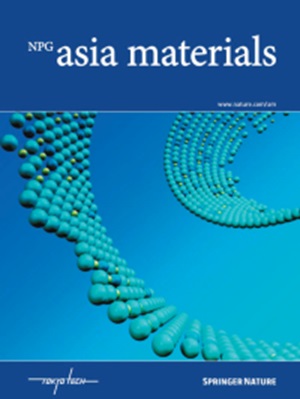基于互补应力和结构调制的金属玻璃回春工程
IF 8.3
2区 材料科学
Q1 MATERIALS SCIENCE, MULTIDISCIPLINARY
引用次数: 0
摘要
残余应力工程广泛应用于新型先进轻量化材料的设计。对于金属玻璃,人们关注的是结构变化和回春过程。高能扫描x射线衍射应变图揭示了缺口金属玻璃在三轴压缩变形后的弹性波动。微压痕硬度映射提示了压缩后的硬化-软化竞争机制,揭示了应力和结构调节的互补效应。透射电镜证实了室温变形下的结构调制和弹性非均质分布与剪切带的形成有关。分子动力学模拟提供了对缺口金属玻璃的受限变形机制和相关的弹性和塑性应变波动的原子性理解。因此,未来的重点应放在应力调制和弹性非均质性上,它们与结构调制一起,可以设计出具有增强延展性和应变硬化能力的金属玻璃。本文章由计算机程序翻译,如有差异,请以英文原文为准。


Rejuvenation engineering in metallic glasses by complementary stress and structure modulation
Residual stress engineering is widely used in the design of new advanced lightweight materials. For metallic glasses, attention has been given to structural changes and rejuvenation processes. High-energy scanning X-ray diffraction strain mapping reveals large elastic fluctuations in notched metallic glasses after deformation under triaxial compression. Microindentation hardness mapping hints at a competing hardening–softening mechanism after compression and reveals the complementary effects of stress and structure modulation. Transmission electron microscopy proves that structure modulation and elastic heterogeneity distribution under room temperature deformation are related to shear band formation. Molecular dynamics simulations provide an atomistic understanding of the confined deformation mechanism in notched metallic glasses and the related fluctuations in the elastic and plastic strains. Thus, future focus should be given to stress modulation and elastic heterogeneity, which, together with structure modulation, may allow the design of metallic glasses with enhanced ductility and strain-hardening ability. In this work, by involving high-energy scanning X-ray diffraction strain mapping, we identify and distinguish between structural and elastic heterogeneity in the extremely rejuvenated metallic glasses under triaxial compression. Microindentation hardness hints at an unsymmetrical hardening/softening picture and further reveals the complementary effects of stress and structure modulation. Our results suggest that simultaneous stress and structural modulation can be used to enhance rejuvenation beyond the limits known to date, and may therefore aid in the design of MGs with enhanced ductility and strain-hardening capability.
求助全文
通过发布文献求助,成功后即可免费获取论文全文。
去求助
来源期刊

Npg Asia Materials
MATERIALS SCIENCE, MULTIDISCIPLINARY-
CiteScore
15.40
自引率
1.00%
发文量
87
审稿时长
2 months
期刊介绍:
NPG Asia Materials is an open access, international journal that publishes peer-reviewed review and primary research articles in the field of materials sciences. The journal has a global outlook and reach, with a base in the Asia-Pacific region to reflect the significant and growing output of materials research from this area. The target audience for NPG Asia Materials is scientists and researchers involved in materials research, covering a wide range of disciplines including physical and chemical sciences, biotechnology, and nanotechnology. The journal particularly welcomes high-quality articles from rapidly advancing areas that bridge the gap between materials science and engineering, as well as the classical disciplines of physics, chemistry, and biology. NPG Asia Materials is abstracted/indexed in Journal Citation Reports/Science Edition Web of Knowledge, Google Scholar, Chemical Abstract Services, Scopus, Ulrichsweb (ProQuest), and Scirus.
 求助内容:
求助内容: 应助结果提醒方式:
应助结果提醒方式:


